
Baron Teynham, of Teynham in the County of Kent, is a title in the Peerage of England and the Peerage of the United Kingdom. It was created in 1616 for Sir John Roper. His great-great-grandson, the fifth Baron, served as Lord Lieutenant of Kent. The latter's third son, the eighth Baron, married, as his second wife, Anne Barrett-Lennard, 16th Baroness Dacre. His eldest son from this marriage, Charles Roper, was the father of Trevor Charles Roper, 18th Baron Dacre, and Gertrude Trevor Roper, 19th Baroness Dacre. His youngest son from this marriage, Reverend Richard Henry Roper, was the great-great-great-grandfather of the historian Hugh Trevor-Roper, Baron Dacre of Glanton.

Earl of Buckinghamshire is a title in the Peerage of Great Britain. It was created in 1746 for John Hobart, 1st Baron Hobart.
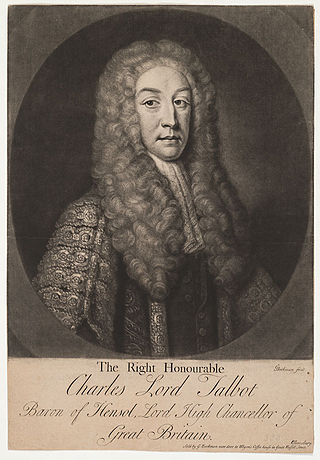
Earl Talbot is a title that has been created twice in the Peerage of Great Britain. This branch of the Talbot family descends from the Hon. Sir Gilbert Talbot, third son of John Talbot, 2nd Earl of Shrewsbury. His great-great-great-grandson, the Right Reverend William Talbot, was Bishop of Oxford, of Salisbury and of Durham. His eldest son Charles Talbot was a prominent lawyer and politician. In 1733, he was raised to the Peerage of Great Britain as Lord Talbot, Baron of Hensol, in the County of Glamorgan, and then served as Lord High Chancellor of Great Britain from 1733 to 1737.

Baron Ellenborough, of Ellenborough in the County of Cumberland, is a title in the Peerage of the United Kingdom. It was created on 19 April 1802 for the lawyer, judge and politician Sir Edward Law, Lord Chief Justice of the King's Bench from 1802 to 1818. His son, the second Baron, notably served as Governor-General of India. On 22 October 1844 the second Baron was created Viscount Southam, of Southam in the County of Gloucester, and Earl of Ellenborough, in the County of Cumberland. These titles were also in the Peerage of the United Kingdom. His only son predeceased him and on his death in 1871 the viscountcy and earldom became extinct.

Baron Denman, of Dovedale in the County of Derby, is a title in the Peerage of the United Kingdom. It was created in 1834 for the prominent lawyer, judge and Whig politician Thomas Denman. He served as Lord Chief Justice of the King's Bench from 1832 to 1850. His son, the second Baron, assumed in 1876 by royal licence the additional surname of Aitchison, which was that of his father-in-law. He was succeeded by his grandnephew, the third Baron. He was the grandson of the Hon. Richard Denman, younger son of the first Baron. Lord Denman notably served as Governor-General of Australia from 1911 to 1914. He was succeeded by his eldest son, the fourth Baron. On his death in 1971, the title passed to his first cousin, Sir Charles Denman, 2nd Baronet, of Staffield, who became the fifth holder of the title.

Baron Trevor is a title that has been created three times. It was created first in 1662 in the Peerage of Ireland along with the viscountcy of Dungannon. For information on this creation, which became extinct in 1706, see Viscount Dungannon.

Walter FitzUryan Rice, 7th Baron Dynevor was a British military officer, civil servant and Conservative politician. He was the only son and heir of the 6th Baron Dynevor.
Cecil de Cardonnel, 2nd Baroness Dynevor was a Welsh peeress.
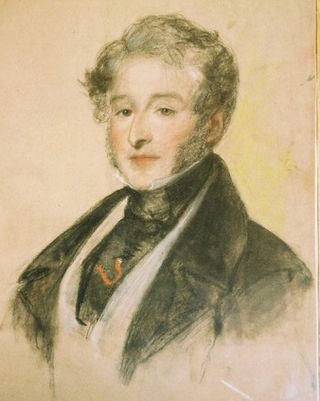
George Talbot Rice, 3rd Baron Dynevor (Dinefwr) was a British peer and politician. He was the son of Cecil de Cardonnel, 2nd Baroness Dynevor and George Rice. He was educated at Westminster School and matriculated at Christ Church, Oxford on 1 February 1783, where he was awarded a Master of Arts degree on 30 May 1786.

George Rice-Trevor, 4th Baron Dynevor was a British politician and peer.

Francis William Rice, 5th Baron Dynevor was a British clergyman and peer. He was the second son of the Reverend Edward Rice, Dean of Gloucester himself second son of the 2nd Baroness Dynevor. The Dean's wife, Rice's mother, Charlotte Lascelles though born the illegitimate daughter of General Francis Lascelles and Ann Catley, a singer, was a niece of Edward Lascelles, 1st Earl of Harewood.
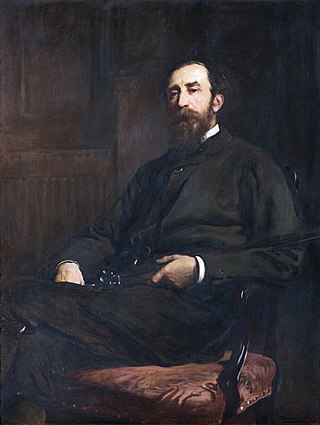
Arthur de Cardonnel FitzUryan Rice, 6th Baron Dynevor, was a British peer.

Charles Arthur Uryan Rhys, 8th Baron Dynevor CBE, was a British peer and politician. He was the son of Walter FitzUryan Rice, 7th Baron Dynevor.

Richard Charles Uryan Rhys, 9th Baron Dynevor was a British peer.

Arthur Edwin Hill-Trevor, 1st Baron Trevor, styled as Lord Edwin Hill until 1862 and as Lord Edwin Hill-Trevor from 1862 to 1880, was a long-standing Anglo-Irish Conservative Member of Parliament.
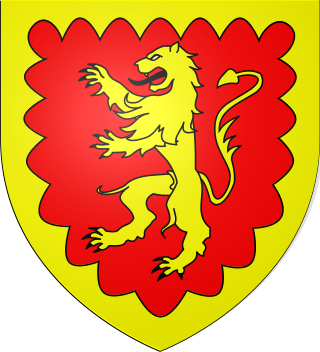
The Royal House of Dinefwr was a cadet branch of the Royal House of Gwynedd, founded by King Cadell ap Rhodri, son of Rhodri the Great. Their ancestor, Cunedda Wledig, born in late Roman Britain, was a Sub-Roman warlord who founded the Kingdom of Gwynedd during the 5th century, following the Anglo-Saxon settlement of Britain. As Celtic Britons, the House of Dinefwr was ruling before the Norman conquest, having to fight with their neighbors such as the Celtics, Anglo-Saxons and Vikings, before struggling with the Normans afterwards. Many members of this family were influential in Welsh history, such a Hywel Dda, who codified Welsh law under his rule, and achieved the important title of King of the Britons, or Lord Rhys, Prince of Wales, who rebelled against Richard the Lionheart, and became one of the most powerful leaders of the Middle ages.

Newton House is a Grade II* listed country house situated just to the west of the market town of Llandeilo in Carmarthenshire, Wales. It is partially owned and maintained by the National Trust and lies within Dinefwr Park and the grounds of Dinefwr Castle. The park and gardens are listed on the Cadw/ICOMOS Register of Parks and Gardens of Special Historic Interest in Wales. The original house was built during the Medieval period on a site which has been occupied for at least two millennia. The current house was built by Edward Rice in the Jacobean style in 1660, though extensive changes were made in the 1850s in the Venetian Gothic style. The house played a role in the Rebecca Riots of 1843, when the occupant of the house at the time, Colonel George Rice, received a death threat with an empty grave dug in the ground. After 1956 the property fell into turbulent times when two owners died within the space of a few years. It was sold in 1974, and later fell into disrepair; it was occupied by squatters and thieves who removed beams and furniture.

Hugo Griffith Uryan Rhys, 10th Baron Dynevor is a British hereditary peer.

George Rice was a Welsh politician and courtier.
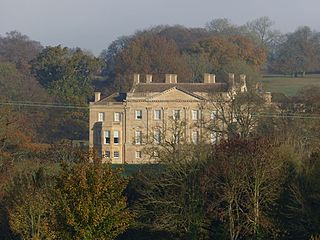
Barrington Park is a Palladian style country house standing in an estate of the same name near the villages of Great Barrington and Little Barrington, Gloucestershire, England. It is a Grade I listed building. The parkland in which it stands is Grade II* listed.



















